|
|
|
|
Products mentioned in this Article
|
|
|
|
|
|
|
|
|
 |
|
|
|
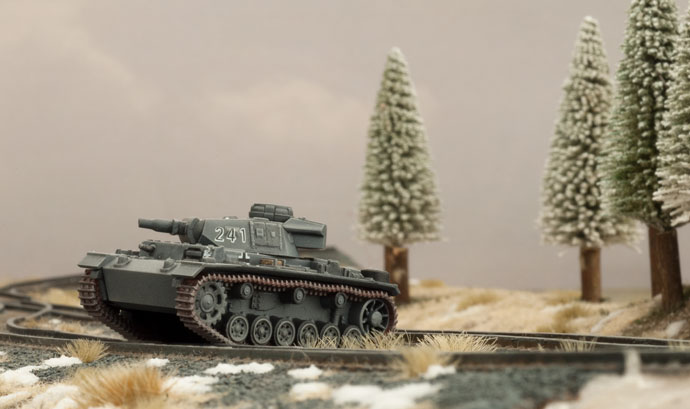
|
The Panzer III On The Eastern Front
with Adam Brooker
With the release of Iron Cross, I thought it might be a good idea to look at the Panzer Forces that the Wehrmacht had available in 1942 in their push to defeat the Soviet Forces. In particular the Panzer III, which formed the backbone of the German armour forces up to 1943.
|
| After the German Army was repulsed at the front steps of Moscow in December 1941 with the help of General Winter, there was a period of counter attacks and offensives by both sides, between the end of Winter and Spring in early 1942, with particular bloody fighting around Kharkov and the Crimea. By June 1942 the Germans and their allies were ready to start their Summer Offensive – Case Blue to regain the initiative and capture the vital oil fields in the Caucasus that were imperative for Germany to secure so they could continue their invasion of the Soviet Union. |
Iron Cross
By the end of 1941, the German blitzkrieg had swept across open plains of the Soviet Union and stopped at the gates of Moscow as winter set in. The halt was only temporary as the Germans were back on the offensive in the summer of 1942. The attack sliced into the southern front, aiming at the oilfields of the Caucasus. Two army groups charged forward, one heading to the mountain country in the south, the other focussed on a small city on the Volga River called Stalingrad. The unstoppable German offensive was pushing Soviet morale to a breaking point as the most pivotal battles on the Eastern Front were about to be fought on the streets of Stalingrad and in the Russian Steppe.
Learn more about Iron Cross here... |
 |
|
Early in Operation Barbarossa, Soviet armour was largely inferior to the German Panzer III and IV, with only the new designs like the T-34 or KV-1, providing any serious obstacle. But they were too few in number to slow down the German advance, although for the Germans simply that they existed was a shock, as they did not expect the Soviets to have tanks such as these.
|
|
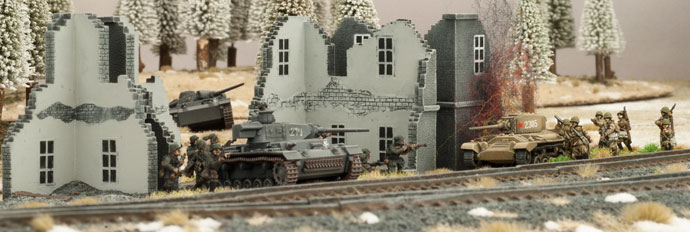
|
|
In the battles of 1942 and 1943, the T-34 and KV-1 would be a much more common opponent with the Soviet tank factories being able to 30-40 tanks a day after being relocated to the Urals. Also with the Allied Lend Lease Program, the Germans faced tanks like the American M3 Lee, M3 Stuart and the British Valentine. So consequently in fielding a Panzer Force from Iron Cross, a German General should be expecting to face a wide range of enemy armour.
|
|
The basic Panzer III you have available in Iron Cross is the Panzer III short 5cm (Panzer III Ausf. J), this was equipped with a 5cm KwK 38 L/42 gun. At 5 points each it is cheapest Panzer you can field, with a Front Armour of 5 and a Side/Rear of 3, and a Top of 1, it is reasonably well protected. Already early in the invasion of the Soviet Union, it was noted that this gun could not reliably penetrate tanks like the T-34 or KV-1, unless at extremely close ranges or in the sides of rear and even then it was difficult. Also of note, all variants of the Panzer III had armoured ammunition bins, which meant they would be less likely to cook off when hit, so in game you have a better remount roll.
Pictured right: Panzer III (short 5cm)
|
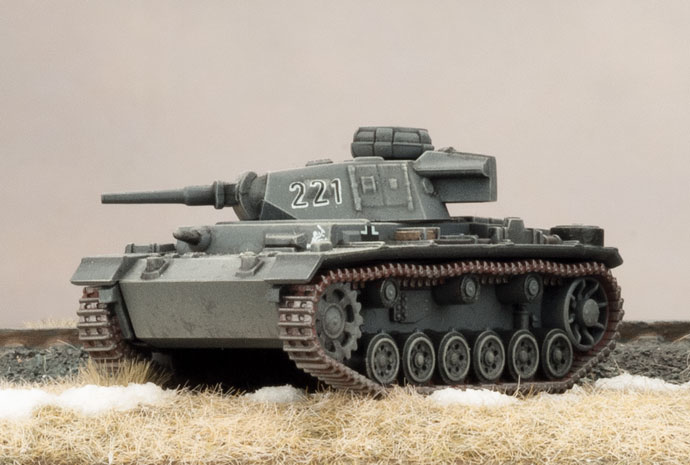
|
|
In Flames Of War the gun has a range of 24”, AT 8 and a Firepower of 4+. This means that it will do well versus light tanks like the T-60, M3 Stuart but once you face heavier tanks like the T-34, M3 Lee and KV-1 you will struggle. At long range you can only bail a T-34 and even at short range you cannot bail a KV-1 from either the front or sides. Conversely T-34, M3 Lee and KV-1 can all penetrate you at range. You can see why the Germans wanted to up-gun and up-armour this tank quickly after encountering the new Soviet tanks. This tank is best suited to engaging lighter Soviet armour and units, like armoured cars and light tanks, and can be a decent assault tank in a pinch, provided nearby anti tank guns are taken out.
|
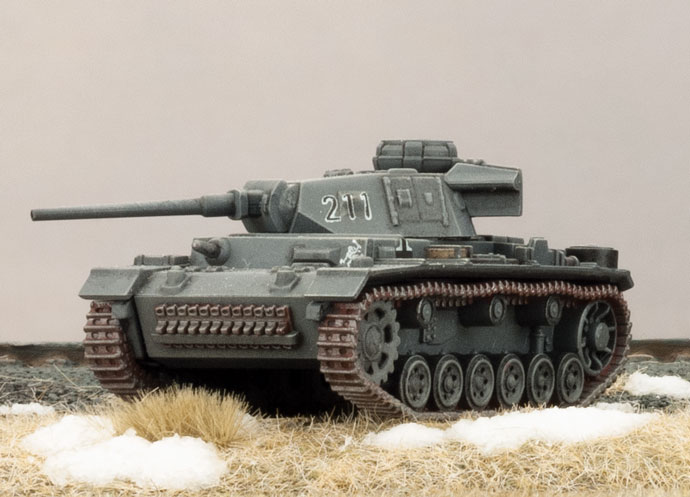 |
The next iteration of the Panzer III was the upgrading of the gun to a longer 5cm cannon (the 5cm KwK L/60 gun). The additional length increased the muzzle velocity of the cannon which allowed it better penetration against the T-34 and KV-1. But it was found that this still was not enough to reliably penetrate the heavier Soviet armour and these Panzer III (long 5cm) were still considered to be in the Ausf. J series. It was noted that the armour protection of the Panzer III was insufficient against newer Soviet guns so an additional 20cm of stand-off armour plate was added to the hull and turret fronts. These models with both the long 5cm cannon and increased armour are called the Panzer III (Uparmoured), or Panzer III Ausf. L to the historians, with the 28” AT 9 gun and the increased front armour of 6.
Pictured left: Panzer III (Long 5cm)
|
|
In game, the extra range and armour penetration of the 5cm long cannon, will mean that you have a better chance in penetrating the T-34, and at short range you can bail a KV-1 from the side, but it is still not ideal. It is not until the introduction of the long 7.5cm gun (7.5cm KwK 40 L/43) on the Panzer IV chassis, that the Germans had a gun that could reliably penetrate the T-34 and KV-1. The smaller Panzer III chassis could not mount this gun in its turret, and was eventually phased out in favour of the Panzer IV.
|
|
But all is not lost, with the clever use of skills like Blitz and Shoot & Scoot, you can engage tanks like the M3 Lee and T-34 at long ranges with your full ROF, then move back out of range with your superior 3+ Skill rating. This will mean unless your opponent passes a successful Blitz test (on their generally worse Skill/Tactics rating), they will have to move to engage you, so will have a reduced Rate of Fire. You can also do this to move in and out of short range, but remember it is not guaranteed, and relies on lady luck being on your side.
Pictured right: Panzer III (Uparmoured)
|
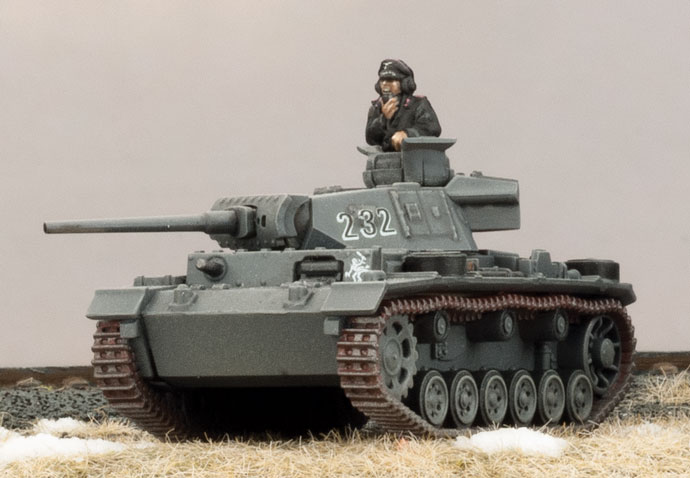
|
|
So with the Panzer III being replaced in the anti-tank role by newer tanks such as the Panzer IV and the Panther, it was decided to find a new role for this reliable tank. By fitting it with the short 7.5cm low velocity gun (7.5cm KwK 37 L/24) from the early Panzer IV, they produced the final variant of the Panzer III (7.5cm), or Ausf.N infantry support tank. This gun used primarily HE and HEAT rounds, with the HE howitzer type rounds being very effective against infantry, machine gun nests and towed guns. The shaped charge HEAT rounds were also reasonably effective against enemy armour, and hardened fortifications, so could be used against enemy armour if needed. Also as HEAT rounds did not require high velocity to penetrate, but rather their warheads explosive energy, they do not lose penetrating ability at long ranges. Around 700 of these were produced in 1942/43, either new from the factory, or by refurbishing older models.
|
|
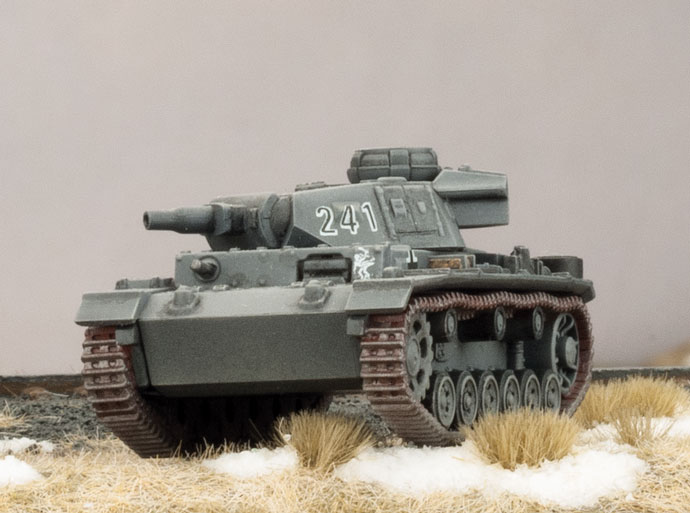
|
In game this means with the short 7.5cm armed variant you have 24” range, AT9, but an increased Firepower of 3+. You also the HEAT special rule (you do not increase the enemies armour rating by 1, at ranges over 16”), but you cannot up-armour this variant, so your Front Armour is only 5. This makes this tank better at taking out dug in infantry and gun teams, with the improved firepower, and a little bit more effective at killing medium tanks like the T-34, M4 Sherman and Valentine, as range will not reduce your AT.
Pictured left: Panzer III (7.5cm)
|
|
Be careful however, as your Front Armour of 5 means most tanks can penetrate you frontally, and taking out enemy tanks is not this Panzers primary function. It should be used to support your infantry in taking objectives and killing gun teams. Leave the tank hunting for units like the Marder or Panzer IV long 7.5cm, with their higher AT and longer ranges, as that is what they do best.
|
|
The excellent Panzer III chassis was used as the basis for the Sturmgeschutz III assault gun – StuG III. Long after they stopped producing the Panzer III they still continued to use the chassis to produce over 10,000 of one of the Wars most successful self propelled guns. It was the single most produced German armoured fighting vehicle of the war with many older Panzer III tanks being returned to the factories to be converted into assault guns. Even after being replaced by the Panzer IV and Panther as the main German medium tank, it was still (in a way) being used until 1945 when the war ended and beyond.
|
|
Overall this tank was a jack of all trades for the German Wehrmacht in the early years of the war, and while it was good for its time, its limitations led to the development of the Panther medium tank. The period around Iron Cross and Ghost Panzers (Stalingrad to Kursk) was the last hurrah for the Panzer III as new models began to replace it.
Just like how the Panzertruppen used their superior tactics and skills, to overcome the newer Allied tanks, you will need to learn to do the same. Make sure you attack only when it is at your advantage as you will almost always be outnumbered and when you do, hit hard. As Heinz Guderian, the father of Blitzkreig said, "You hit somebody with your fist, not with your fingers spread!".
~Adam
|
|
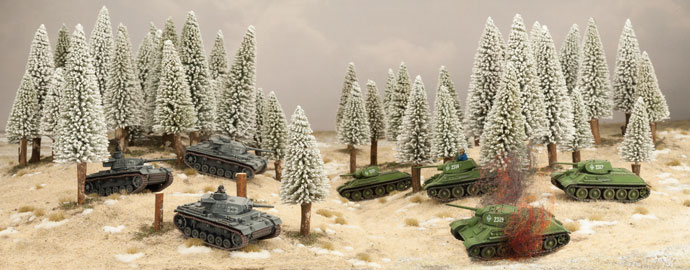
|
Last Updated On Thursday, September 6, 2018
|
|
|